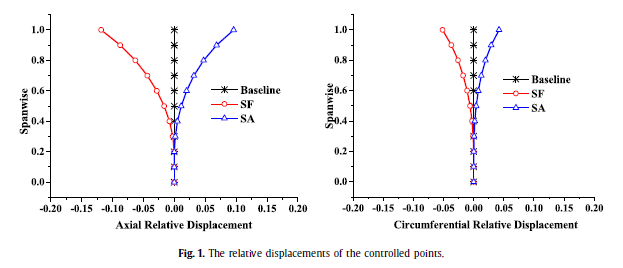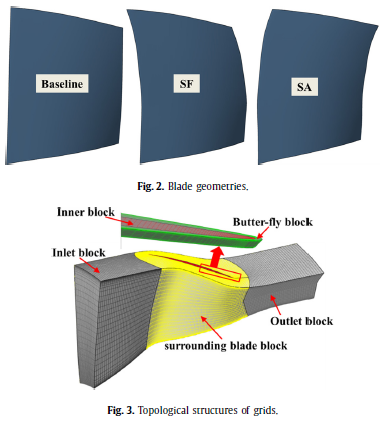A new view of internal blade loading match is employed in this paper to reveal the essential relationship between sweep and complicated flow phenomenon in compressors. A forward swept rotor named as SF and an aft swept rotor named as SA, are designed originating from NASA Rotor 37. The numerical results indicate the isentropic efficiency and total pressure ratio of the new rotor with forward sweep are a little larger than rotor Baseline at peak efficiency point, and its stall margin has an over 10% increase as well. By contrast, the opposite change appears in the aft swept rotor SA. In addition, the choking massflow of swept rotors changes clearly as a result of the spatial change of aerodynamic throat and the forward sweep produces a larger throat area and choking massflow. A noted phenomenon is shown that both forward and aft sweep benefit a certain range of blade span for flow characteristic improvement, and the sweep also affects the inflow condition, 3-D shock structure and internal loading distributions of swept rotors. Both the new radial equilibrium in flow field and transportation of low-energy fluids in boundary layer induced by sweep appear conductive to reduce shock wave and flow blockage in tip region of forward swept rotor SF. Meanwhile, the strength of leakage flow is also suppressed in the forward swept rotor SF because of the decreased blade loading near leading edge in tip region. In fact, all the change in swept rotors tends to be a new characteristic match of blade airfoil at different span, and the re-matching of flow characteristic for blade airfoil determines the stable operation range and the overall performance of swept rotors at design point directly.
Conclusion
Highly loaded transonic rotors with sweep are designed by translating the stacking axis of NASA Rotor 37 in chordwise di-rection, and the swept rotors are studied by numerical simulation in this paper. The results show both the peak efficiency and total pressure ratio have increased for forward swept rotor SF in com-parison with unswept rotor Baseline at peak efficiency point, and its stall margin has improved over 10% as well. By contrast, the overall performance of has decreased for aft swept rotor SA. Mean-while, the choking massflow of swept rotors changes clearly as a result of the spatial change of aerodynamic throat, and the forward sweep produces a larger area of aerodynamic throat and choking mass flow for blade.
The aerodynamic sweep has different influence on different span of rotor. Therefore, both forward sweep and aft sweep benefit to flow characteristic improvement in a certain span of swept ro-tors, which affects new radial and streamwise loading distributions in swept rotors. The additional radial pressure gradient produced by forward sweep attenuates the accumulation of low-energy flu-ids, which weakens the passage shock in tip region and pushes the shock front far away from leading edge of blade. Meanwhile, the strength of leakage flow is also suppressed because of the decreased loading near leading edge in tip region of the forward swept rotor. Therefore, the aerodynamic losses and flow blockage in tip region has decreased obviously in the forward swept rotor SF and its stall margin is also improved.
The aerodynamic sweep has changed the inflow conditions and the characteristic match of each blade airfoil at different span of rotors. First, because of the new radial equilibrium near leading edge induced by sweep, the inlet static pressure and relative Mach number present new distributions in spanwise direction. Second, as the inlet conditions change in swept rotors, the flow character-istic of each blade airfoil in span changes accordingly, especially the 3-D shock structure. Therefore, the characteristic of blade air-foil at different span present a new radial match for rotor, which determines the overall performance of the whole swept rotors di-rectly.

